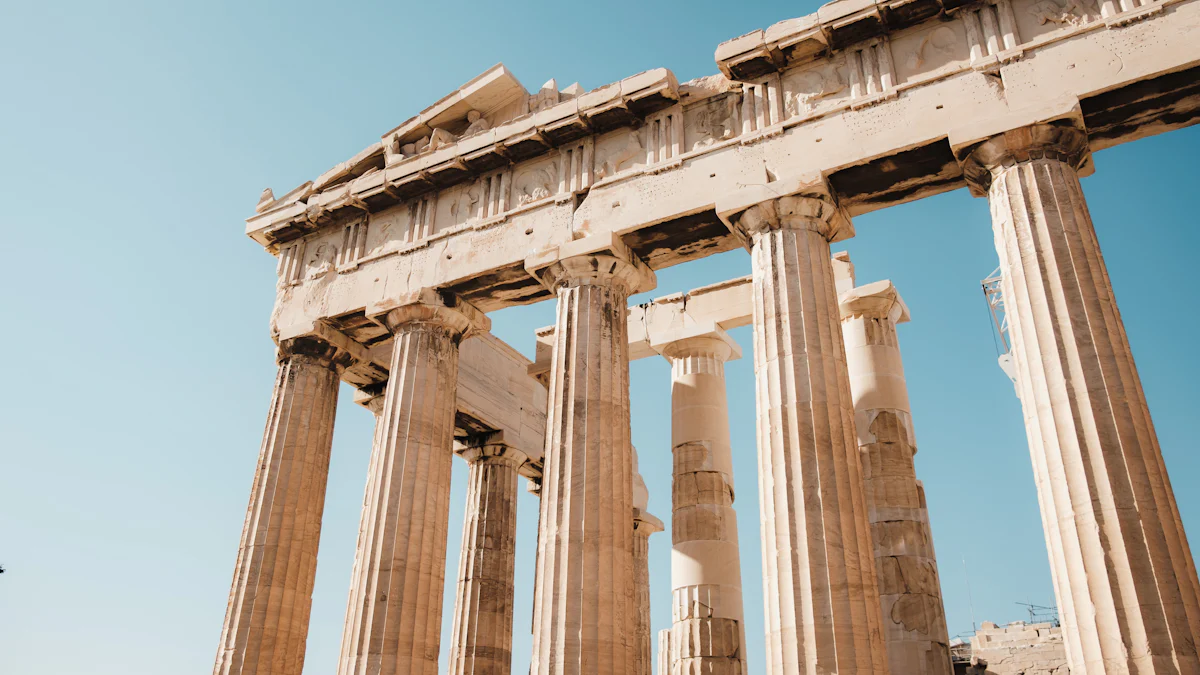Architecture: A Visual History

Architecture acts as a visual history, showcasing the evolution of buildings and human progress. These structures reflect cultural shifts and technological advancements. The history of architecture has seen rapid evolution, with new designs surpassing classical orders in grandeur. The Union of Romanian Architects building exemplifies changes in style and materials over centuries. Revival Architecture gained popularity in the 19th and early 20th centuries, influencing cities worldwide. Understanding these transformations provides insight into how architecture shapes and mirrors society.
Ancient Architecture

Egyptian Architecture
Pyramids of Giza
The Pyramids of Giza stand as monumental achievements in ancient Egyptian architecture. These structures reflect the Egyptians' advanced understanding of engineering and construction techniques. The pyramids served as tombs for pharaohs, demonstrating the importance of the afterlife in Egyptian culture. Builders used massive limestone blocks to create these iconic structures. The precise alignment with the cardinal points highlights the Egyptians' astronomical knowledge. The Pyramids of Giza continue to influence modern architecture with their grandeur and precision.
Temples of Karnak
The Temples of Karnak showcase the architectural prowess of ancient Egypt. This vast complex served as a religious center dedicated to the god Amun-Ra. The grand columns and intricate carvings demonstrate the Egyptians' artistic skills. Builders constructed the temples over several centuries, reflecting the evolving architectural styles. The Hypostyle Hall remains a highlight, with its towering columns and detailed reliefs. The Temples of Karnak inspire architects today with their scale and beauty.
Greek Architecture
Parthenon
The Parthenon represents the pinnacle of ancient Greek architecture. Located on the Acropolis in Athens, this temple honors the goddess Athena. The Parthenon's design embodies the principles of classical architecture, including symmetry and proportion. Builders used marble to create the temple's iconic columns and intricate sculptures. The Parthenon influences contemporary buildings worldwide, showcasing the lasting impact of Greek architectural principles.
Temple of Hephaestus
The Temple of Hephaestus stands as a well-preserved example of ancient Greek architecture. This temple, dedicated to the god of craftsmanship, features Doric columns and a rectangular layout. The use of marble and detailed friezes highlights the Greeks' artistic abilities. The Temple of Hephaestus reflects the importance of religion in Greek society. Modern architects draw inspiration from its harmonious design and enduring beauty.
Roman Architecture
Colosseum
The Colosseum exemplifies the grandeur of Roman architecture. This massive amphitheater hosted gladiatorial games and public spectacles. The Romans used concrete and stone to construct the Colosseum, showcasing their engineering prowess. The structure's elliptical shape and tiered seating accommodated thousands of spectators. The Colosseum remains an iconic symbol of Roman innovation and architectural achievement. Contemporary stadiums often draw inspiration from its design.
Pantheon
The Pantheon stands as a testament to Roman architectural ingenuity. This temple, dedicated to all the gods, features a massive dome with an oculus at its center. The Romans used concrete to create the dome, demonstrating their advanced building techniques. The Pantheon's harmonious proportions and innovative design continue to influence modern architecture. The structure's enduring appeal lies in its blend of functionality and aesthetic beauty.
Medieval Architecture
Romanesque Architecture
St. Sernin Basilica
St. Sernin Basilica stands as a prime example of Romanesque architecture. Builders constructed this basilica in Toulouse, France, during the 11th century. The design features rounded arches and thick walls, reflecting Roman architectural influences. St. Sernin's layout includes a large nave and radiating chapels. The use of stone vaults enhances the building's stability and grandeur. Visitors admire the intricate sculptures adorning the exterior.
Speyer Cathedral
Speyer Cathedral represents the Romanesque style in Germany. Construction began in the early 11th century under Emperor Conrad II. The cathedral's massive structure showcases rounded arches and sturdy columns. Builders used red sandstone to create a striking appearance. Speyer Cathedral's crypt remains one of the largest in Europe. This architectural marvel continues to draw visitors with its historical significance.
Gothic Architecture
Notre-Dame de Paris
Notre-Dame de Paris exemplifies Gothic architecture. The cathedral's construction began in the 12th century. Builders employed innovations like flying buttresses and ribbed vaults. These features allowed for taller and more ornate structures. Notre-Dame's facade displays intricate sculptures and stained glass windows. The cathedral's towering spires emphasize verticality. Visitors marvel at the artistry and engineering of this iconic building.
Chartres Cathedral
Chartres Cathedral stands as a masterpiece of Gothic architecture. Located in France, the cathedral was completed in the 13th century. The design incorporates pointed arches and expansive glass windows. Builders used flying buttresses to support the structure. Chartres Cathedral's rose window remains a highlight of Gothic art. The cathedral's grandeur and beauty continue to inspire architects today.
Renaissance Architecture
Italian Renaissance
Florence Cathedral
Florence Cathedral stands as a symbol of the Italian Renaissance. Filippo Brunelleschi designed the iconic dome, showcasing innovative engineering techniques. Builders used brick and stone to create the structure. The cathedral's facade features intricate marble designs. Visitors admire the harmonious blend of art and architecture. Florence Cathedral continues to inspire architects worldwide.
St. Peter's Basilica
St. Peter's Basilica represents a masterpiece of Renaissance architecture. Donato Bramante played a key role in its design. The basilica's grand dome dominates the skyline of Vatican City. Builders used marble and gold to enhance the interior's beauty. The vast nave and ornate altars reflect religious significance. St. Peter's Basilica remains a central figure in architectural history.
Northern Renaissance
Antwerp City Hall
Antwerp City Hall exemplifies Northern Renaissance architecture. The building features a blend of Gothic and Renaissance styles. Builders used sandstone and marble for the facade. The structure's symmetry and decorative elements attract visitors. Antwerp City Hall serves as a testament to the region's architectural evolution. The building continues to influence modern civic architecture.
Heidelberg Castle
Heidelberg Castle stands as a prominent example of Renaissance architecture in Germany. The castle's construction began in the 13th century. Builders expanded it during the Renaissance period. The structure features ornate facades and grand halls. Visitors explore the castle's rich history and architectural beauty. Heidelberg Castle remains a significant landmark in European architecture.
Modern Architecture

Art Deco
Chrysler Building
The Chrysler Building in New York City exemplifies Art Deco style. Architects used geometric patterns and metallic finishes to create its iconic design. The building's spire features a sunburst motif, symbolizing progress and modernity. Visitors admire the intricate details and grandeur of this skyscraper.
Empire State Building
The Empire State Building stands as another masterpiece of Art Deco architecture. Builders completed the structure in 1931, making it the tallest building at that time. The limestone facade and aluminum spire highlight the era's design principles. The Empire State Building remains a symbol of innovation and ambition.
Bauhaus
Dessau Bauhaus Building
The Dessau Bauhaus Building represents the Bauhaus movement's core principles. Walter Gropius designed the structure with a focus on functionality and simplicity. Glass walls and flat roofs characterize the building's modern aesthetic. The Dessau Bauhaus Building continues to influence contemporary architecture.
Fagus Factory
The Fagus Factory showcases early Bauhaus architecture. Designers used steel and glass to create an open and airy workspace. The factory's design emphasizes efficiency and modern industrial techniques. The Fagus Factory remains a landmark in architectural history.
Contemporary Architecture
Burj Khalifa
The Burj Khalifa in Dubai holds the title of the world's tallest building. Architects designed the structure with a sleek and futuristic appearance. The tower's height and design reflect advancements in engineering and technology. The Burj Khalifa attracts visitors from around the globe.
Sydney Opera House
The Sydney Opera House stands as an icon of contemporary architecture. Jørn Utzon designed the building with a series of white sail-like shells. The unique design and waterfront location make it a cultural landmark. The Sydney Opera House inspires architects with its innovative form and function.
Architecture showcases a journey through time, highlighting the evolution of styles and innovations. Ancient civilizations laid the groundwork for modern design, influencing current architectural practices. Historical styles, with their grandeur and beauty, continue to inspire contemporary architects. Modern architecture embraces structural advancements like steel and glass, allowing for creative experimentation. Both historic and modern buildings shape city skylines, leaving lasting impressions on society. Understanding past achievements helps architects design spaces that blend functionality with aesthetic appeal, creating environments that inspire and endure.
See Also
Visual Encyclopedia: The History of America
The Past: A New Perspective on History
A Visual Journey Through the American Revolution

